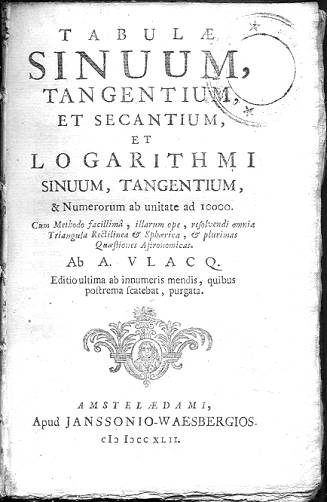Vlacq Table of Logarithms, 1742
Acquired during april 2004 at the Dutch Circle stand in a collectors fair from a retired instrumentmaker at the Agricultural University of Wageningen.

Shown to the audience of IM2004 on 26 September 2004, according to the following
Principles of Collecting:
Numerous Years of Publication for Vlacq’s Log Tables
(limited scan from Leiden Museums, Bierens de Haan and ZVAB/antiquarian bookhandlers)
| 1628 F-L (Arithm. Log. II) |
| 1636 D (10 x 100,000) |
| 1651 F-L (100,000) |
| 1657 D (100,000) |
| 1658 D (7 x 10,000, octavo) |
| 1661 D-F-G-L (10,000) |
| 1665 D-F-G-L (100,000) |
| 1666 F (100,000) |
| 1670 F (10,000 postuum) |
| 1673 G (10,000) |
| 1681 L (10,000) |
| 1683 D (10,000) |
| 1689 G (10,000) |
| 1690 F (10,000) |
| 1695 G (10,000) |
| 1706 G (10,000) |
| 1721 Chinese Arithm. Log. II |
| 1721 G (10,000) |
| 1725 G (10,000) |
| 1732 G (10,000) |
| 1738 G (10,000) |
| 1742 L (10,000) |
| 1748 G (10,000) |
| 1757 G-L (10,000) |
| 1760 F (10,000) |
| 1763 G (10,000) |
| 1768 G (10,000) |
| 1775 G (10,000) |
| 1778 G (10,000) |
| 1784 L (10,000) |
| 1790 L (10,000) |
| 1808 G (10,000) |
| 1821 G (10,000) |
| LEGEND |
| D=Dutch: „Nieuwe Konstige Tafelen … „ |
| F=French: „Tables de Sinus … „ |
| G=German: „Tabellen der Sinuum … „ |
| L=Latin: „Tabulae Sinuum … „ |
Cooperation between Vlacq and de Decker
|
Adriaan Vlacq |
Ezechiel de Decker |
| 1600 born in Gouda | |
| 1603 born in Leiden | |
| 1621 moves to Gouda as surveyor & teacher | |
| 1624 reads Briggs’ „Arithm. Log.“ and
starts planning a completer version |
|
| 1625, 24/12: obtains copyright for plan | |
| 1625, 17/12: signs partnership contract with D. | |
| 1626, 4/9 publishes „Nieuwe telkonst part I“ | |
| 1626, 31/12: summons D. to calculate part II | and appitiser for part II with existing logtables |
| 1627 publishes „Nieuwe telkonst part II“ | |
| „Het Groote Werk“: 10 x 100,000 | |
| 1628 publishes French and Latin versions of | (Rediscovered by Haaften in 1920) |
| „Arithm. Log. Part II extended“ | |
| (Copper plates for tables used from D.) | |
| 1631 moves to Rotterdam, maritime work | |
| 1632 opens bookshop in London | |
| 1636 prints first „own“ version of 1628 Tables | |
| 1642 opens bookshop in Paris | |
| 1647 dies in Rotterdam | |
| 1648 opens bookshop in The Hague | |
| 1667 dies in The Hague |
Some other thoughts and questions on log tables
- Hundreds of errors have been reported in the Vlacq tables, presumably in the last digit(s), but largely corrected in newer editions
- Ranges (1-100,000) are better expressed in digit precision (e.g. 4 digits in, by 7 out), which should be „balanced“ to each other (Briggs was too precise with 14 digits out)
- Were John Napier’s log-tables really practical?
With logarithms of sines, the calculation types are very limited:
only sin(a) : sin(b) = sin(c) : sin(x), as used in spherical trigonometry - Who calculated Vlacq’s Trig tables? Or was it copied from Edmund Gunter’s „Canon Triangularum“? Did Gunter compute these himself?
- Gunter introduced a log-sine with values between 0 and 9.xxxxxxx, based on his assumption of an extremely large angle radius.
Why did log-sin tables keep this caracter convention deep into the 20th century, long after the sine had been redefined to a radius of unity, resulting actually in a negative log-sine value?
Autor: Otto van Poelje
